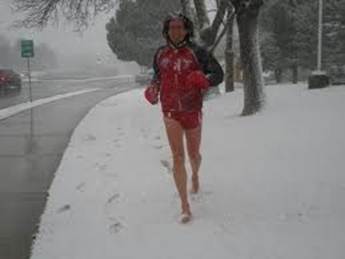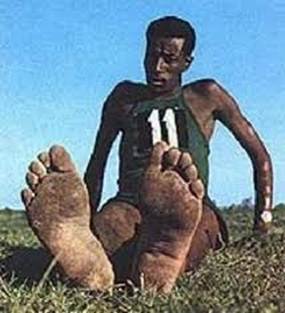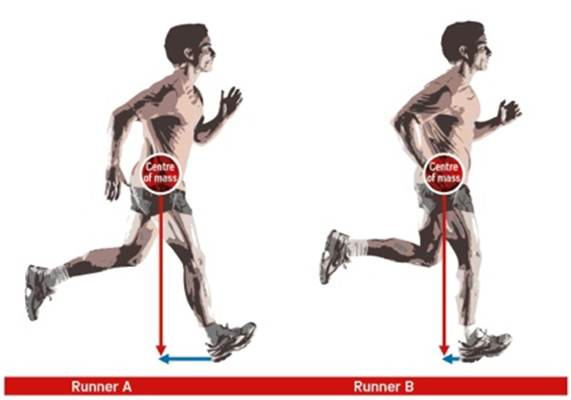The changing face of running footwear
Recently I began a trial of switching my running trainer from a more traditional type to a 'new' style. Here's why:
Barefoot, minimalist, lightweight, natural etc all terms for the new group of running footwear stirring up the running world (at least on the internet forums). I was always aware a few people ran barefoot – Zola Budd in her elite running years for example (incidentally she now states she would rather be running in shoes) and that many ran in lightweight footwear (racing flats) come race day, so I did not see this as anything new when the buzz began a few years back nor did I believe the hype.

But where did it come from? I think the fact that the current running shoe prescription model of prescribing footwear based on how ‘pronated your foot is’ was proving to be flawed, overly simplistic and not preventing injury led to many seeking a new answer. To highlight this Ryan et.al, (2010) randomly assigned footwear to 3 groups of female runners. These were a neutral trainer (Nike Pegasus), stability (Nike structure triax) and motion control (Nike Nucleus). The participants were separated into 3 groups of neutral, pronated or highly pronated via the foot posture index but not necessarily given the footwear their footype would get in a running store assessment. They found that in the highly pronated group those given stability footwear (as they would be in a store assessment) 100% of the participants suffered some form of injury. Whilst of those given a neutral shoe with a highly pronated foot type only 40% suffered injury. They also noted those in the neutral group who ran in neutral trainers reported greater pain than those in the neutral group who wore a stability shoe. There were additional findings further conflicting our current theory of running footwear prescription. For a more detailed assessment of that argument I would recommend a read of Ian Griffiths’ excellent blog titled “Choosing Running Shoes: The Evidence Behind the Recommendations”.
So the minimalist/lightweight call it what you like bandwagon rumbled on and more and more patients were asking my opinion especially as it began to seep into the national press with Lieberman et.al, (2010) and their work on how do humans run? They claim that before the 1970's when the modern running trainer began to incorporate the larger levels of cushioning and 'motion control' for example runners ran barefoot or in lightweight footwear and did so either with midfoot or forefoot strike. They go on to find that "barefoot runners who forefoot strike generated smaller collision forces than shod runners with a rear foot strike". Lets just explore those two points.

First of all the claim that runners ran fore or midfoot strike before the modern running shoe. According to data from Hasegawa et.al, (2007) investigating elite level runners during a half marathon 74.9% were rearfoot strikers, 23.7% were midfoot strikers and 1.4% forefoot. These runners as elites would likely be running in lightweight racing footwear. So Leiberman et.al, are suggesting that at least 75% of runners have changed running style since 1970 to a rearfoot strike as a result of 'overbuilt' trainers. Such a change in a large group I think is impossible.
Secondly the collision force being less in a barefoot forefoot strike runner. The research is contradictory with Lieberman et.al, (2010) stating this and Hamill et.al, (2011) agreed. However DeWit et.al, (1996) and Stockton and Dyson (1998) found this force was increased in barefoot running. This inconsistency shows that it may be subject specific and relative to the runner and their experience. Contrary to the barefoot mantra that this lower impact peak/collision force is protective Nigg (1997) noted that in fact those with higher loading rates had significantly lower injury rates. His theory was one of a muscle-tuning model which dampens these forces. Basically muscle contraction kicks in to attenuate this force at higher impact.
So is someone missing the point somewhere? All this focus on elevated impact peaks/collision force yet no link that this is a cause of injury. There are other variances between barefoot and shod running such as increased tibial acceleration, increased ankle plantarflexion, increased pre activation of gastrocnemius and/or soleus, lowered mechanical stress on knee but increased at ankle when barefoot running. However these are only findings and like impact peaks are not directly linked to increased injury risk.
So far much contradiction and still no proof as to how I should be running or what to wear. However I was intrigued, as someone who used to play football at a high level I wore football boots as light and as flexible as possible. Of course they were terrible for support and foot function but I felt the ball better in them, thought I ran faster in them and I thought would play better in them so I was happy to trade that off against the injury risk. Would I feel like I was running faster in lightweight running trainers? There was only one way to find out, I would give a pair a go.
I run to keep fit generally for other sports. I don’t enjoy it that much, it clears your head sometimes after a long day but generally I do find it a drag. Especially when I trained for the Great North Run the long runs really bored me. I did my two North Runs in Asics 2120, what they call a ‘motion control’ (can motion be controlled – not according to Williams et.al, (2003) and an Asics footwear employee I heard lecture, enhanced - maybe) trainer and got around on both occasions in a little under 2 hours.
The times were not important, I did it to keep fit and raise a few pounds for good causes so when I thought about doing another run I wanted to enjoy it a bit more and this tied in nicely with my lightweight running trial.
The internet forums are awash with barefoot/lightweight running information but its Pete Larssons well balanced runblogger blog that I visit regularly for a well researched review and view on the latest footwear and literature in this area. So I embarked on training for a run in the Saucony Kinvaro as Pete had talked them up in his review and I felt they were a good introduction to the lightweight runner world (though some argue are more of a lightweight 'neutral' shoe). I was worried because of the heel drop of only 4 mm given I was used to 12mm and have particularly tight gastrocnemius and soleus muscles but was reassured that the Kinvaro had a thicker sole (18mm heel and 14mm forefoot), not as thin as some of the lightweight footwear so perhaps easier to adjust to so I went for it.
The next decision was do I adjust my foot strike – I am a regular heel strike runner generally but I looked into the literature to guide me. As previously discussed around 75% are natural heel strikers and I am in that camp. Humans are the only mammals who have a varied foot fall pattern and this seems to be surface dependent. Hamill et.al, (2011) noted that when moving from running on a soft to a harder surface 65% of runners changed their footfall pattern to a midfoot or forefoot strike. He also noted in further research that using a computed model rearfoot striking was most efficient and forefoot striking allowed to increase maximum speed but was not as economical. This ties in with Niggs work in 2001 that the body will find the most economical way to move or its 'preferred motion pathway'. That was good enough for me so I stopped thinking and just ran.
I was however rightly or wrongly conscious about overstriding as this makes mechanical sense that I would be ‘running with the brakes on’ if I were overstriding due to the position of the initial ground reaction force being anterior to my centre of mass. The idea that initial contact should be roughly in line with your body seems to make sense to use that force in assisting to transition the body forwards.

So how did it feel? Well good to be honest. It compared to running just after fracturing my tibia when I was carrying a bit of extra weight to a few months later when I had lost it. The first 5 minutes I felt free, like I wanted to run as fast as I can but had to hold myself back as sensibly I knew I had much further to go. Of course I still got fatigued toward the end, the shoes didn’t give me any superpowers but I did enjoy the run. I started at a fairly moderate 2 mile run building up as the weeks went by to a maximum of 4 before the British 10k in London. Although I felt some ITB tightness on the day (more as a result of conditioning than shoes as I have suffered this in years gone by) the run was a thoroughly enjoyable day and I couldn’t believe when the finish line was in front of me, it seemed to go by so quick (actually the opposite finishing in around 50mins). Time didn’t bother me, it was the enjoyment that I had gained whilst training and doing the run.
The use of a lightweight shoe does seem to show some metabolic benefits when compared to barefoot - Franz (et.al, 2012) compared running barefoot to a lightweight running trainer in reference to VO2 max and found that the lightweight trainer reduced VO2 by between 2.7%-4.1%. Perhaps barefoot running requires greater muscular contribution.
Lightweight, racing shoes are I think still best suited to race day but they can have a role in the everyday enjoyment of the leisure time runner and training pattern of the more competitive runner. The way my calf’s felt the day after I think a slightly higher heel differential would have been ideal, or should I just stretch my calf’s more? If we are looking for potential mechanism for injuries that reduced heel height is certainly one. If I was to run on a more regular basis would other injuries come along, maybe. If I were to seriously train for another half marathon or marathon I think a selection of footwear of more rigid design to lightweight on a mixture of surfaces would be the way to go to A) prevent boredom and B) prevent injury.
So what does this prove? Nothing really other than that I (N=1) found running more enjoyable in lightweight footwear over a short distance <10Km and did not experience any injuries. It does not show that lightweight footwear should replace all other running footwear and will solve all of our problems. As for barefoot running and forcing a forefoot running style I think may be suited to a small number but is certainly not for everyone. It does stress different tissues and some who suffer certain pathologies this may help, others it will hinder. If it was that good wouldn't all the elite athletes be doing it, if you spot a barefoot runner at London 2012 let me know and I will buy you a beer (probably have to be a Heineken, payed for on a Visa card....another story).
For those out there confused and just want to run and avoid injury I think the sensible advice is:
- Build up mileage gradually
- Vary your running surface
- Vary your running shoes or lack of
- Do some conditioning on appropriate muscle groups
- Just run, enjoy it and don't think about it to much!
References
DeWit, B. DeClercq, D. and Aerts, A., 1996, Ground reaction forces and spatio-temporal variables during barefoot and shod running, 14 International Symposium on Biomechanics in Sports
Franz, J.R. Wierzbinski, C.M. and Kram, R., 2012. Metabolic cost of running barefoot versus shod: Is lighter better? Medicine and Science in Sports and Exerciseahead of print
Hamill, J. Russella, E.M. Grubera, A.H. and Millera, R., 2011. Impact characteristics in shod and barefoot running, Footwear Science, 3(1), pp.40
Hasegawa, H. Yamauchi, T. and Kraemer, W.J., 2007. Foot strike patterns of runners at the 15-km point during an elite-level half marathon, Journal of Strength and Conditioning Research / National Strength & Conditioning Association, 21(3), pp.888-893
Lieberman, D.E. Venkaesen, M. Werbel, W.A. Daoud. A.I. D’Andrea, S. Davis, I.S. Mang’Eni, R.O. and Pitsiladis, Y., 2010. Foot strike patterns and collision forces in habitually barefoot versus shod runners, Nature, 463, pp.5531-535
Nigg, B., 1997. Impact forces in running. Current Opinion in Orthopaedics, 8(6), pp.43-47
Nigg, B., 2001. The role of impact forces and foot pronation: A new paradigm, Clinical Journal of Sports Medicine, 11, pp.2-9
Ryan, M.B. Valiant, G.A. and McDonald, K., 2010. The effect of three different levels of footwear stability on pain outcomes in women runners: a randomised controlled trial, British Journal of Sports Medicine, online Stockton
M. and Dyson, R., 1998. A comparison of lower extremity forces, joint angles, and muscle activity during shod and barefoot running, 16 International Symposium on Biomechanics in Sports
Williams, D.S. Davis, I.M. and Baitch, S.P., 2003. Effect of inverted orthoses on lower extremity mechanics in runners, Medicine and Science in Sport and Exercise, 35, pp.2060-2068
P.S. Although I had most of these references previously I must thank those I have seen lecture these last few years discussing this topic and led me to several of the above papers.